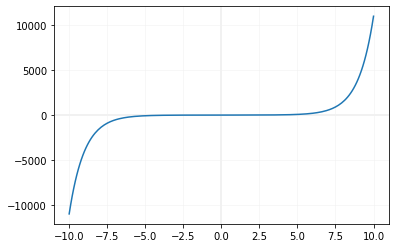sinh()
import math
print(math.sinh(-1)) # -1.1752011936438014
print(math.sinh(-1.5)) # -2.1292794550948173
print(math.sinh(-5)) # -74.20321057778875
print(math.sinh(0)) # 0.0
print(math.sinh(1)) # 1.1752011936438014
print(math.sinh(1.5)) # 2.1292794550948173
print(math.sinh(5)) # 74.20321057778875Inputs in degree
We can convert radian value to degree and use the sameimport math
in_degree = 60
in_redian = math.radians(in_degree)
print(math.sinh(in_redian)) # 1.2493670505239751 1 radian = 57.2957914331 degree
1 degree = 0.0174533 radian
1 degree = 0.0174533 radian
Drawing graph of sinh()
We will use Matplotlib to generate graph of sinh
import matplotlib.pyplot as plt
x=[]
y=[]
i=-10
while (i<=10):
x.append(i)
y.append(math.sinh(i))
i=i+0.1
plt.axvline(x=0.00,linewidth=2, color='#f1f1f1')
plt.axhline(y=0.00,linewidth=2, color='#f1f1f1')
plt.plot(x,y)
plt.grid(linestyle='-',
linewidth=0.5,color='#f1f1f1')
plt.show()Example 1: Symmetry of sinh()
import math
x = 2
print(math.sinh(x)) # Output: 3.626860407847019
print(math.sinh(-x)) # Output: -3.626860407847019 (symmetric)Example 2: Calculating sinh() for Small Angles
import math
angle = 0.1 # Small angle in radians
print(math.sinh(angle)) # Output: 0.10016675001984403Example 3: Calculating sinh() for Large Values
import math
large_value = 10
print(math.sinh(large_value)) # Output: 11013.232874703393
Example 4: Using sinh() in a Mathematical Formula
import math
x = 1.5
y = 2.0
result = 2 * math.sinh(x) + 3 * math.sinh(y)
print(result) # Output: 15.13914013373069Example 5: Comparing sinh() with Other Hyperbolic Functions
import math
x = 2.0
sinh_val = math.sinh(x)
cosh_val = math.cosh(x)
tanh_val = math.tanh(x)
print(f"sinh: {sinh_val}, cosh: {cosh_val}, tanh: {tanh_val}")sinh: 3.6268604078470186, cosh: 3.7621956910836314, tanh: 0.9640275800758169
Subhendu Mohapatra
Author
🎥 Join me live on YouTubePassionate about coding and teaching, I publish practical tutorials on PHP, Python, JavaScript, SQL, and web development. My goal is to make learning simple, engaging, and project‑oriented with real examples and source code.
Subscribe to our YouTube Channel here
This article is written by plus2net.com team.
https://www.plus2net.com

 Python Video Tutorials
Python Video Tutorials